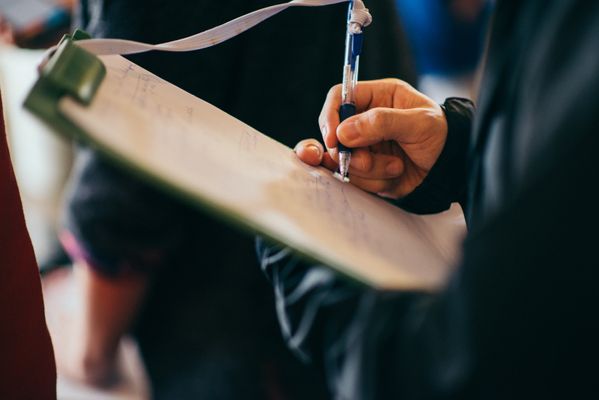1.3.3
Surveys
Surveys
Surveys
Surveys are used to collect primary quantitative data from large groups of people. They are usually carried out using structured questionnaires or interviews.


Surveys
Surveys
- Surveys are used to collect primary quantitative data from large groups of people.
- They are usually carried out using structured questionnaires or interviews.


Generalisability
Generalisability
- Surveys aim to be representative and generalisable to wider populations, and not just the people studied.
- To do this, sociologists collect information from a smaller representative group, drawn from the whole survey population.
- A sample will not be representative if it is too small or if the sampling frame (the list of names of all the those included in the survey population) is not complete.


Carrying out a survey
Carrying out a survey
- Decide on a hypothesis (an idea, theory or question to investigate).
- Operationalise concepts – put an abstract idea or theory into a form that is measurable.
- Conduct a pilot study – a small-scale practice survey so that the researcher can highlight any unforeseen problems.
Sampling Methods
Sampling Methods
Surveys are used to collect primary quantitative data from large groups of people. They are usually carried out using structured questionnaires or interviews.


Generalisability
Generalisability
- Surveys aim to be representative and generalisable to wider populations, and not just the people studied.
- To do this, sociologists collect information from a smaller representative group, drawn from the whole survey population.
- A sample will not be representative if it is too small or if the sampling frame (the list of names of all the those included in the survey population) is not complete.


Sampling methods
Sampling methods
- Random sampling:
- Every individual in the survey population has an equal chance of being picked out for investigation.


Systematic sampling
Systematic sampling
- Systematic sampling:
- Names are selected from the sampling frame at regular intervals until the desired size is reached.


Stratified random sampling
Stratified random sampling
- Stratified random sampling:
- The sampling frame is subdivided (stratified) into a number of smaller sampling frames based on particular characteristics (e.g. gender, social class).
- A random sample is then taken from this frame.


Quota sampling
Quota sampling
- Quota sampling:
- The survey population is stratified and interviewers then find a quota of people who fit the criteria.


Snowball sampling
Snowball sampling
- Snowball sampling:
- Used when a sample of a sampling frame is hard to obtain.
- The researcher identifies a small number of people with desired characteristics and asks them to introduce them to other people who might be willing to cooperate.
1Theory & Methods
1.1Sociological Theories
1.2Sociological Methods
2Education with Methods in Context
2.1Role & Function of the Education System
2.2Educational Achievement
2.3Relationships & Processes Within Schools
3Option 1: Culture & Identity
3.1Conceptions of Culture
3.2Identity & Socialisation
3.3Social Identity
3.4Production, Consumption & Globalisation
4Option 1: Families & Households
4.1Families & Households
4.2Changing Patterns
4.3The Symmetrical Family
4.4Children & Childhood
5Option 1: Health
5.1Social Constructions
5.2Social Distribution of Healthcare
5.3Provision & Access to Healthcare
5.4Mental Health
6Option 1: Work, Poverty & Welfare
6.1Poverty & Wealth
7Option 2: Beliefs in Society
7.1Ideology, Science & Religion
7.2Religious Movements
7.3Society & Religion
8Option 2: Global Development
8.1Development, Underdevelopment & Global Inequality
8.2Globalisation & Global Organisations
8.3Aid, Trade, Industrialisation, Urbanisation
9Option 2: The Media
9.1Contemporary Media
9.2Media Representations
10Crime & Deviance
10.1Crime & Society
10.2Social Distribution of Crime
Jump to other topics
1Theory & Methods
1.1Sociological Theories
1.2Sociological Methods
2Education with Methods in Context
2.1Role & Function of the Education System
2.2Educational Achievement
2.3Relationships & Processes Within Schools
3Option 1: Culture & Identity
3.1Conceptions of Culture
3.2Identity & Socialisation
3.3Social Identity
3.4Production, Consumption & Globalisation
4Option 1: Families & Households
4.1Families & Households
4.2Changing Patterns
4.3The Symmetrical Family
4.4Children & Childhood
5Option 1: Health
5.1Social Constructions
5.2Social Distribution of Healthcare
5.3Provision & Access to Healthcare
5.4Mental Health
6Option 1: Work, Poverty & Welfare
6.1Poverty & Wealth
7Option 2: Beliefs in Society
7.1Ideology, Science & Religion
7.2Religious Movements
7.3Society & Religion
8Option 2: Global Development
8.1Development, Underdevelopment & Global Inequality
8.2Globalisation & Global Organisations
8.3Aid, Trade, Industrialisation, Urbanisation
9Option 2: The Media
9.1Contemporary Media
9.2Media Representations
10Crime & Deviance
10.1Crime & Society
10.2Social Distribution of Crime
Unlock your full potential with Seneca Premium
Unlimited access to 10,000+ open-ended exam questions
Mini-mock exams based on your study history
Unlock 800+ premium courses & e-books